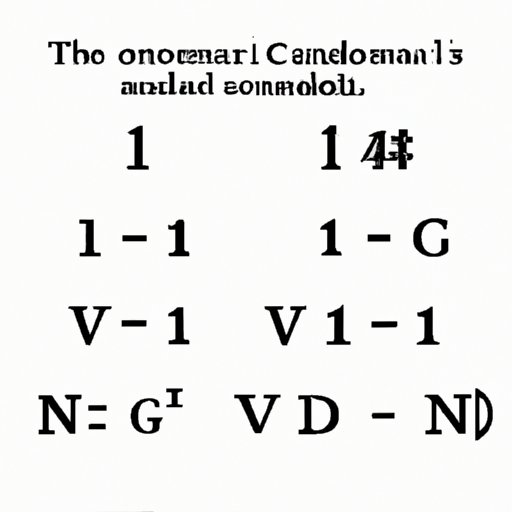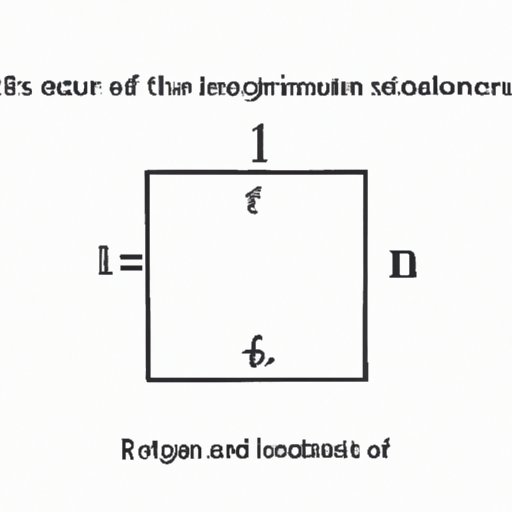
Introduction
Many of us have been told that it is impossible to square root a negative number. We are often taught that negative numbers have no square roots, even in high school algebra. But is this really true? The answer is both yes and no. In reality, we can square root negative numbers, but we need to dive into the world of imaginary numbers to do so. In this article, we will explore the fascinating world of imaginary numbers and explain how they allow us to square root negative numbers.
The Myth of Square Rooting Negative Numbers: An Exploration of Imaginary Numbers
The problem of squaring negative numbers has puzzled mathematicians for centuries. The ancient Greeks believed that negative numbers had no square roots, and this notion persisted well into the 16th century. However, in the 16th century, the Italian mathematician Gerolamo Cardano introduced the concept of imaginary numbers. Imaginary numbers are not fake or impossible; they are simply numbers that involve the square roots of negative numbers. In other words, imaginary numbers are complex numbers that have a real and an imaginary part.
Debunking the Square Root of Negative One: How Complex Numbers Work
In mathematics, complex numbers are numbers that have a real part and an imaginary part. They are usually represented in the form a + bi, where a and b are real numbers and i is the imaginary unit, which represents the square root of -1. Complex numbers can be added, subtracted, multiplied, and divided, just like real numbers. To add or subtract two complex numbers, we add or subtract their real and imaginary parts separately. To multiply two complex numbers, we use the distributive property and combine like terms. To divide two complex numbers, we use a special method called conjugates.
For example, let’s say we want to add (2+3i) and (5+6i). To do so, we add the real parts (2+5=7) and the imaginary parts (3+6=9i). Therefore, the sum is 7+9i.
Understanding the Basics of Imaginary Numbers and their Role in Square Rooting Negative Numbers
The square root of a negative number can be expressed as a complex number that involves the imaginary unit i. For example, the square root of -9 can be expressed as 3i, since (3i)² equals -9. Similarly, the square root of -16 can be expressed as 4i, since (4i)² equals -16.
To find the square root of a negative number, we simply take the square root of its absolute value and multiply it by i. For instance, the square root of -25 is 5i, since (5i)² equals -25.

Solving the Enigma of Square Rooting Negative Numbers: Exploring the Concept of i
The imaginary unit i is the key to solving the problem of square rooting negative numbers. By defining i as the square root of -1, mathematicians have been able to extend the set of real numbers into the realm of complex numbers. The imaginary unit i can be used to represent complex numbers in a more concise way, making mathematical expressions easier to work with.
For example, let’s say we want to calculate the square root of -15. To do so, we write -15 as -1 times 15. Then, we take the square root of 15 and multiply it by i. So, the square root of -15 is equal to the square root of 15 times i, or √15i.
The Application of Imaginary Numbers in Real Life: Demystifying the Mathematics of Square Rooting Negative Numbers
Imaginary numbers are not just mathematical abstractions; they have real-world applications as well. They are frequently used in fields such as engineering, physics, and economics to represent physical quantities that involve both real and imaginary components. For example, in electrical engineering, imaginary numbers are used to represent reactive power, which is the part of electricity that oscillates back and forth between a load and a source. In physics, imaginary numbers are used to represent wave functions, which describe the behavior of particles at the quantum level. In economics, imaginary numbers are used to represent interest rates that include both real and inflation components.
The Fascinating History of Imaginary Numbers and Their Use in Solving the Mystery of Square Rooting Negative Numbers
The history of imaginary numbers is a fascinating one. They were first viewed as problematic by mathematicians, who believed that negative numbers had no square roots. However, Gerolamo Cardano introduced the concept of imaginary numbers in the 16th century, which paved the way for the development of complex numbers. Even then, mathematicians were skeptical of their usefulness, and the concept of imaginary numbers was met with resistance for centuries. It wasn’t until the 18th century that mathematicians began to fully embrace the concept of complex numbers and recognize their importance. Today, complex numbers are essential tools for solving a wide range of mathematical problems.
The Unconventional World of Imaginary Numbers: A Guide to Square Rooting Negative Numbers and Much More
Imaginary numbers may seem unconventional and abstract, but they are an essential part of modern mathematics and have many practical applications. By understanding the basics of complex numbers and imaginary numbers, we can solve problems that were once thought impossible. Furthermore, exploring the world of imaginary numbers can be a rewarding experience that expands our understanding of mathematics and the universe. So, don’t be afraid to dive in and explore this fascinating world.
Conclusion
In conclusion, square rooting negative numbers is not only possible but necessary in many fields of study, and imaginary numbers provide a way to do so. By understanding the basics of imaginary numbers and complex numbers, we can solve mathematical problems that were once thought impossible. Furthermore, understanding the history and applications of imaginary numbers can be a fascinating and rewarding experience. So, embrace the world of imaginary numbers and explore this fascinating subject further.





